No matter how technologically advanced we become, or how accurate our weather forecast models are, mother nature maintains the ability to quickly remind us of how little control we have over her. Winters are notorious for impacting those who underestimate seasonal hazards or fail to prepare. For every extreme winter story of the skiers, climbers, or Arctic explorers who surmounted incredible odds to survive, there exists a counter narrative of the Captain Oates of the world—the intrepid explorer who died during the Terra Nova Antarctic expedition, sacrificing himself so that others could survive. Now these are extreme examples and while the majority of us will never be buried by an avalanche or lost freezing in the dark, these incidents serve as an essential reminder that hazards change with the seasons and so too must our preparedness measures.
Most of us cannot escape the shorter, darker days, the need for additional layers, or the buildup of ice and frost on our car windshields. Fortunately, the Office of Response and Restoration’s Disaster Preparedness Program reminds us that we can typically foresee and prepare for the risks associated with winter weather. Therefore, when you find yourself donning heavier clothing, you should also make it a habit to review what necessary winter preparedness measures will ensure the safety of your home, vehicle, and physical and behavioral health during the coldest months.
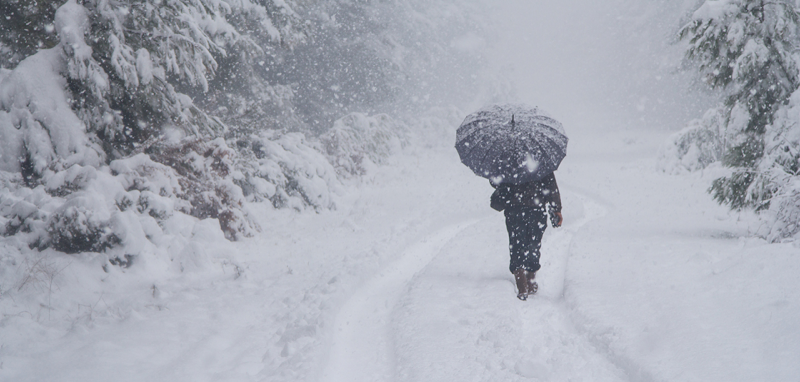
This winter may feel a bit different than past winters. People remain at home, working and schooling remotely. Forced inside by the shorter, darker, and colder days, our home internet quality, patience, and productivity is affected. Some of our typical outside activities might be limited by public health concerns. Seasonal affective disorder might become more prevalent. What we should not do is allow seasonal hazards to compound the stressors already felt. To mitigate this risk requires planning. The Disaster Preparedness Program recommends the following considerations to keep you and your family safe at home, at work, or out on the roads this winter.
Slips, Trips and Falls
Typically, the hazards we encounter most frequently are the ones that we become complacent to. Slips, trips, and falls occur often during the winter months from frost, snow or ice accumulation, which makes the ground uneven or slick. We track melting snow and water inside our homes, which makes the floors slippery. Help prevent injuries from slips and falls by:
- Take your time! Most falls occur when you are in a hurry.
- Take smaller steps and keep both feet on the ground.
- Avoid carrying too many items at once. Try to keep at least one hand free to help maintain your balance.
- Wear appropriate shoes that are warm with traction.
- Try to keep walkways, stairs, and where you park free of snow and beware of black ice.
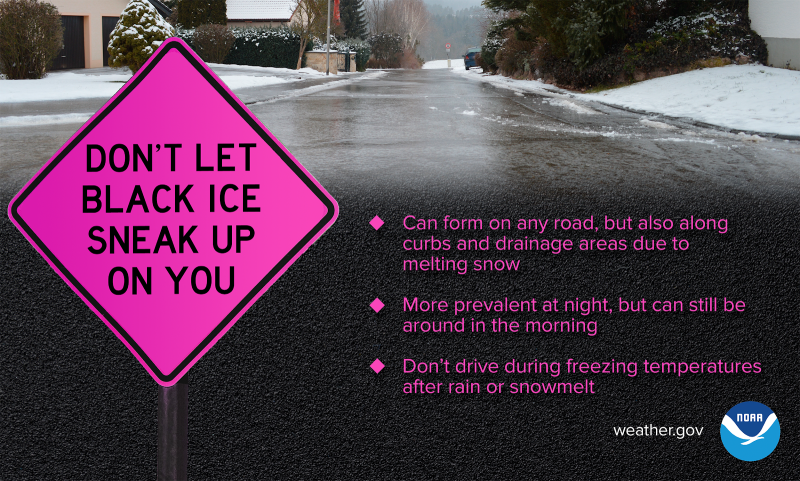
Winter Fires
Holiday decorations, heating, candles, and winter storms compound the risk of accidental fires during the colder months. According to the National Fire Protection Agency, electrical fires are a leading cause of home fires in the United States. Heating comes in at a close second and causes numerous domestic house fires, deaths and injuries annually, peaking in December, January, and February.
We love those little portable space heaters, but have to be careful! Space heaters are involved in two out of every five home heating equipment fires.
- Always place space heaters on a solid, flat surface at least three feet away from anything flammable. That includes people!
- Only plug space heaters directly into a wall outlet.
- Only use space heaters when an individual is in the same room. Turn off and unplug the heater when not in use.
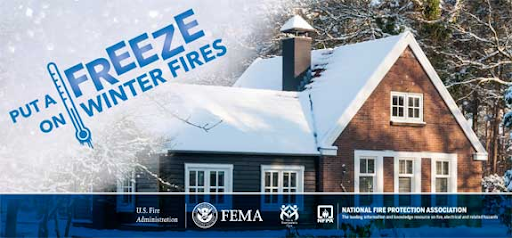
Carbon Monoxide
No winter preparedness message would be complete without emphasizing the importance of maintaining your smoke and carbon monoxide (CO) detectors in good working order.
-
Maintain these alarms according to the manufacturer’s instructions; however, make a habit of pressing the test button on the smoke alarm every month.
-
Keep in mind that these alarms do not last forever. Replace smoke detectors every ten years.
Smoke alarms save lives; however, often called the invisible killer, CO poisoning is a serious hazard during the cold winter months. A colorless, odorless, and tasteless gas, a person can be poisoned by a small amount of CO over a longer period of time, or by an acute amount over a shorter amount of time. CO gas is created when fuels like gasoline, charcoal, natural gas, propane, oil, and methane burn incompletely.
Colder temperatures necessitate the use of common household items like gas and oil-burning furnaces and propane heaters. Winter storms also have the potential to cause extended power outages and lead to the use of portable generators and gas camp stoves or charcoal grills in an attempt to stay warm. In the home, all of the heating and cooking equipment that burns fuel are potential sources of carbon monoxide. Even running your vehicle or generator in an attached garage can produce dangerous levels of carbon monoxide. All of these items can be used safely, but within critical guidelines:
-
Make sure you have battery operated or battery backup CO detectors near sleeping areas in the house.
-
If you have an oil or gas furnace, make sure you have it inspected annually.
-
Never run your generator inside the home, garage, or basement. Generators should always be more than 20 feet away from the home and away from any window, door, or vent.
-
Do not use a generator, charcoal grill, camp stove, gasoline, or other charcoal-burning device inside your home, basement, garage, or near a window.
-
Never run your vehicle inside the garage, even with the door open.
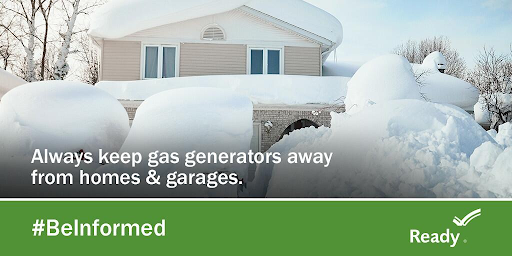
Winter Driving
In the winter, be wary of unsafe driving conditions due to limited visibility, icy roads, or—worst yet—parking on a slope! Some best practices for safe winter driving are:
- Remove snow and ice from windshield, lights, and body of car before driving. This will allow for better visibility, and prevents blocks of packed snow from flying off your vehicle and hitting another behind you.
- Beware of driving during winter storms. Blinding wind driven snow, icy conditions, downed trees, and power lines can put you at greater risk for injury or for becoming stranded in freezing temperatures.
- Winterize your car for optimum visibility and performance in icy/snowy conditions. Ensure wiper blades, headlights and anti-icing fluid are well-maintained. Install snow tires on your vehicle for better traction when routinely driving in snow and icy environments.
- Be cautious on bridges, overpasses, and infrequently traveled roads where you are more likely to encounter slick ice.
- Avoid using cruise control on icy roads.
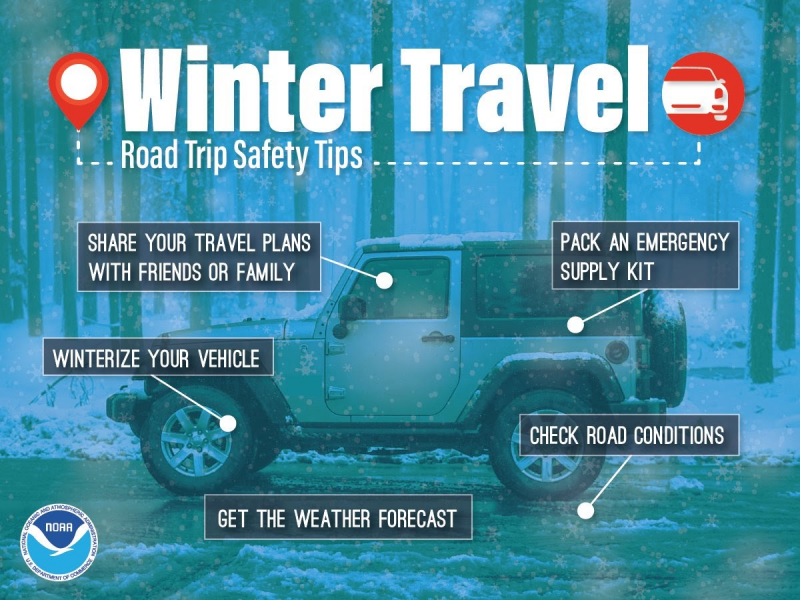
Replenish your emergency kits
- Make sure the kit you prepared earlier in the year has not been pilfered! Key components may include: water, food, flashlight, extra batteries, candles, radio, and any other items that you or your family might need if a winter storm causes a power outage.
- Do not forget about the need to keep an emergency kit in your vehicle as well with items such as a first aid kit, water, food, blankets, extra jacket and change of shoes. You never know when you may become stranded or stuck in a traffic accident. A flashlight, headlamp and external phone charger might also come in handy.
Keep Warm
Extreme cold can take its toll during the winter months and can lead to frostbite and hypothermia if caught unprepared. According to the Center for Disease Control, approximately 1,300 deaths per year from 2006 to 2010 were coded as resulting from extreme cold exposure. Unfortunately, many of those deaths were normal people in normal places who simply ventured out or were otherwise unprepared and got caught up in a severe winter storm.
What if you were told that you can get hypothermia in your own home during a winter storm, and you might not even realize it was happening?
In cold temperatures, your body begins to lose heat faster than it can be produced, eventually using up your body’s stored energy. Hypothermia can be the result of abnormally low body temperature that affects the brain, causing a person to be unable to think clearly or move well. Normal body temperature is around 98.6 degrees Fahrenheit and hypothermia occurs as your body temperature falls below 95° degrees. Look for warning signs of shivering, exhaustion, confusion, memory loss, slurred speech, fumbling hands, or drowsiness. If you notice these signs, check your temperature. If it is below 95° degrees, get medical attention right away.
Hypothermia should not be taken lightly. If you do not have access to professional medical aid, the most important thing you can do for someone with hypothermia is get them into some sort of warm room or shelter, remove or replace wet clothing, and start slowly warming them up. Focus on warming the center of the individual’s body first.
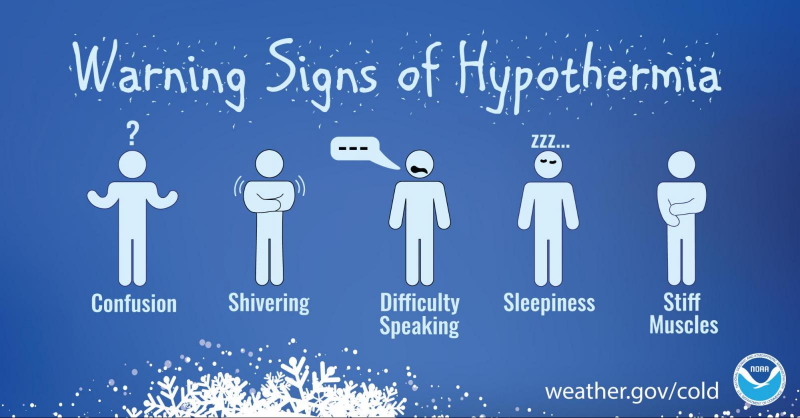
Frostbite is another cold weather health hazard. Frostbite is an injury to the body when temperatures fall below freezing, and causes a loss of feeling and color in affected areas. It most often affects your extremities, so keep your nose, ears, cheeks, chin, fingers, and toes covered. If you have redness, numbness, or pain in any skin area, get out of the cold and protect your skin. Seek medical attention as soon as possible if you detect signs of frostbite.
Don’t forget your Pets
Pets get cold too! Check your winter forecasts often and ensure your pets have adequate shelter and access to water that has not frozen over. The best way to keep your pets safe and warm is to bring them inside. If you have a dog, it’s also important to wipe their paws after walking them outside. Ice melting chemicals can make them sick.
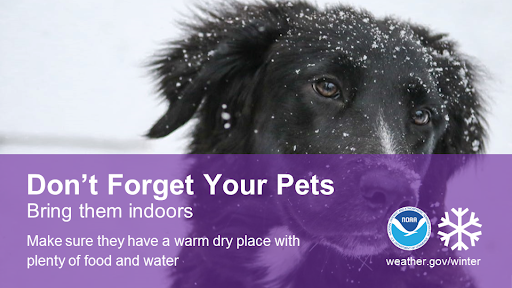
During the winter months, it is important to remain connected and maintain a support network of family and friends to help each other at all times. It has been a challenging year, but by checking in on your neighbors, helping older adults or others who might need a little extra help shoveling snow from their walkway this winter, we can all continue safely into 2021. For more information on winter safety and preparedness, please visit the NOAA National Weather Service website.
